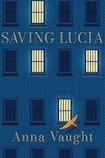
The pages of Saving Lucia are so joyous and full of life that they seem about to flap away. Reading Anna Vaught’s third novel is akin to catching your first glimpse of London’s parakeets. It produces a similar sense of wonderment and disorientation – a feral flash of exotic technicolour splashed across a monochrome canvas.
The seed for this “more-or-less true story” – as the narrator calls it – was planted when Vaught discovered that Violet Gibson and Lucia Joyce had both been inmates of St Andrew’s, a psychiatric hospital in Northampton. History does not say whether the two Irish women ever met, but then this is a book about awaking from its nightmare, not replicating it.
The date is 1956. Violet – daughter of Baron Ashbourne, a former lord chancellor of Ireland – has been locked away for 30 years, following her attempted assassination of Mussolini. Sensing that her time is almost up, this devout Catholic convert with a penchant for profanity (“go fack yourself doctors”) and killer one-liners (“Decorum is essential in a lunatic asylum”) enrols Lucia as her Boswell.
As the title indicates, writing this book will save Lucia – who was committed to St Andrew’s two years earlier – from being reduced to “hearsay and notes in hospital archives” by providing a sounding board for her silenced voice. In fact, the four voices she channels could be construed as different facets of her divided personality. The characters, after all, are often difficult to distinguish, forcing the author to punctuate the text with “I, Lucia” at regular intervals.
Observing Violet muttering to her beloved passerines in the courtyard, Dr Griffith remarks that she seems to be feeding them “with her words”. Little does he know that bird is the word. Communication between the two female protagonists is pitched at a frequency that blurs the boundary between sound and silence.
Wings and writing
On one occasion Lucia is astonished when Violet responds to something she has just been thinking; on others, she catches herself speaking out loud instead of ruminating. The medical staff are unable to tune into this illicit wavelength. When Violet starts whispering to Lucia, at the beginning of their adventure, the nurse “hears it only as rustling and is not sure even if it is there”.
A network of associations running throughout the novel connects whispering to murmuration (a keyword) and rustling to both avian wings and writing. All these elements are brought together in the pivotal scene where the women fly away from St Andrew’s, setting off the hospital’s alarms in the process: “This was the bit the staff heard, but they’d missed the whispers, glissando of the winged helpers no louder than a heartbeat through a greatcoat; rustles of paper and scratches of soft pencil.”
In the beginning was the bird, and the bird was with Violet, and the bird was Violet. Through a process of transubstantiation or recirculation James Joyce would have approved of, Lady Gibson feeds the birds “with her words” which themselves turn into birds, thus enacting the oft-repeated idea that confinement liberates the powers of the imagination.
“Come to us passerines,” she tells them, “Soon enough, we will come with you” – and so they do, accompanied by Blanche (the so-called Queen of Hysterics, whose antics under hypnosis attracted le tout Paris at the end of the 19th century) and Anna O (the originator of the talking cure).
Female madness
The four women travel through time and space, disrupting a seance by Madame Blavatsky and liberating the inmates of La Salpêtrière. These peregrinations climax when they catch up with Mussolini in an attempt to change the course of world history.
Saving Lucia highlights the role played by the patriarchy in defining and weaponising female madness. Is Violet more dangerous than a fascist dictator? Why is Lucia labelled insane whenever the associations she makes become “too lickety-split” while this is deemed a mark of genius in her father, the great author? (The Joycean pastiches are, incidentally, among the most accomplished passages.) And what of Charcot’s exploitative “theatre of neurology”?
“The novel I mentioned? You are reading it,” Lucia explains in the final pages, before adding, “Well I am sure you grasped that. You’re clever.” This is the novel’s major flaw. Despite its inclusive message and celebration of the imagination, everything is relentlessly spelt out. The narrator may well encourage us “to annotate the margins” of her book, but they have all been filled in.
Set against Anna Vaught’s tremendous achievements, however, this criticism is for the birds.










